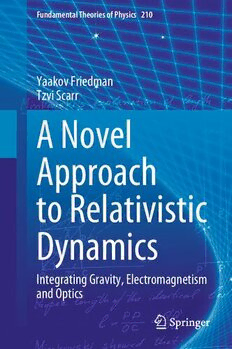Table Of ContentFundamental Theories of Physics 210
Yaakov Friedman
Tzvi Scarr
A Novel
Approach
to Relativistic
Dynamics
Integrating Gravity, Electromagnetism
and Optics
Fundamental Theories of Physics
Volume 210
SeriesEditors
HenkvanBeijeren,Utrecht,TheNetherlands
PhilippeBlanchard,Bielefeld,Germany
BobCoecke,Oxford,UK
DennisDieks,Utrecht,TheNetherlands
BiancaDittrich,Waterloo,ON,Canada
RuthDurrer,Geneva,Switzerland
RomanFrigg,London,UK
ChristopherFuchs,Boston,MA,USA
DomenicoJ.W.Giulini,Hanover,Germany
GreggJaeger,Boston,MA,USA
ClausKiefer,Cologne,Germany
NicolaasP.Landsman,Nijmegen,TheNetherlands
ChristianMaes,Leuven,Belgium
MioMurao,Tokyo,Japan
HermannNicolai,Potsdam,Germany
VesselinPetkov,Montreal,QC,Canada
LauraRuetsche,AnnArbor,MI,USA
MairiSakellariadou,London,UK
AlwynvanderMerwe,GreenwoodVillage,CO,USA
RainerVerch,Leipzig,Germany
ReinhardF.Werner,Hanover,Germany
ChristianWüthrich,Geneva,Switzerland
Lai-SangYoung,NewYorkCity,NY,USA
The international monograph series “Fundamental Theories of Physics” aims to
stretchtheboundariesofmainstreamphysicsbyclarifyinganddevelopingthetheo-
retical and conceptual framework of physics and by applying it to a wide range
ofinterdisciplinaryscientificfields.Originalcontributionsinwell-establishedfields
such as Quantum Physics, Relativity Theory, Cosmology, Quantum Field Theory,
StatisticalMechanicsandNonlinearDynamicsarewelcome.Theseriesalsoprovides
aforumfornon-conventionalapproachestothesefields.Publicationsshouldpresent
new and promising ideas, with prospects for their further development, and care-
fullyshowhowtheyconnecttoconventionalviewsofthetopic.Althoughtheaim
of this series is to go beyond established mainstream physics, a high profile and
open-minded Editorial Board will evaluate all contributions carefully to ensure a
highscientificstandard.
·
Yaakov Friedman Tzvi Scarr
A Novel Approach
to Relativistic Dynamics
Integrating Gravity, Electromagnetism
and Optics
YaakovFriedman TzviScarr
ExtendedRelativityResearchCenter DepartmentofMathematics
JerusalemCollegeofTechnology JerusalemCollegeofTechnology
Jerusalem,Israel Jerusalem,Israel
ISSN 0168-1222 ISSN 2365-6425 (electronic)
FundamentalTheoriesofPhysics
ISBN 978-3-031-25213-6 ISBN 978-3-031-25214-3 (eBook)
https://doi.org/10.1007/978-3-031-25214-3
©TheEditor(s)(ifapplicable)andTheAuthor(s),underexclusivelicensetoSpringerNature
SwitzerlandAG2023
Thisworkissubjecttocopyright.AllrightsaresolelyandexclusivelylicensedbythePublisher,whether
thewholeorpartofthematerialisconcerned,specificallytherightsoftranslation,reprinting,reuse
ofillustrations,recitation,broadcasting,reproductiononmicrofilmsorinanyotherphysicalway,and
transmissionorinformationstorageandretrieval,electronicadaptation,computersoftware,orbysimilar
ordissimilarmethodologynowknownorhereafterdeveloped.
Theuseofgeneraldescriptivenames,registerednames,trademarks,servicemarks,etc.inthispublication
doesnotimply,evenintheabsenceofaspecificstatement,thatsuchnamesareexemptfromtherelevant
protectivelawsandregulationsandthereforefreeforgeneraluse.
Thepublisher,theauthors,andtheeditorsaresafetoassumethattheadviceandinformationinthisbook
arebelievedtobetrueandaccurateatthedateofpublication.Neitherthepublishernortheauthorsor
theeditorsgiveawarranty,expressedorimplied,withrespecttothematerialcontainedhereinorforany
errorsoromissionsthatmayhavebeenmade.Thepublisherremainsneutralwithregardtojurisdictional
claimsinpublishedmapsandinstitutionalaffiliations.
ThisSpringerimprintispublishedbytheregisteredcompanySpringerNatureSwitzerlandAG
Theregisteredcompanyaddressis:Gewerbestrasse11,6330Cham,Switzerland
Preface
This self-contained monograph provides a mathematically simple and physically
meaningful model which unifies gravity, electromagnetism, optics, and even some
quantumbehavior.Thesimplicityofthemodelisachievedbyworkingintheframe
ofaninertialobserverinsteadofincurvedspacetime.
Ourapproachtodynamicsisgeometric,andbyplottingtheactionfunctionofa
spacetime,oneistreatedtoavisualizationofthegeometry.Usingthesevisualiza-
tions,onemayreadilycomparethegeometriesofdifferenttypesoffields.Moreover,
anewunderstandingoftheenergy-momentumofafieldemerges.
Thereaderwilllearnhowtocomputetheprecessionofplanets,thedeflectionof
light, and the Shapiro time delay. Also covered is the relativistic motion of binary
stars,includingthegenerationofgravitationalwavesandarelativisticdescriptionof
spin.
The mathematics is accessible to students after standard courses in multivari-
ablecalculusandlinearalgebra.Forthoseunfamiliarwithtensorsandthecalculus
of variations, these topics are developed rigorously in the opening chapters. The
unifying model presented here should prove useful to upper undergraduate and
graduatestudents,aswellastoseasonedresearchers.
Jerusalem,Israel YaakovFriedman
TzviScarr
Acknowledgments WewouldliketothankLarryHorwitz,RainerWeiss,BahramMashhoon,Dan
Scarr,TepperGill,TzviWeinberger,YakovItin,DavidHaiGootvilig,ElazarLevzion,andChanoch
Cohenfortheircomments.
v
Contents
1 Introduction ................................................... 1
1.1 PhysicsviaGeometry–AHistoricalPerspective ................ 1
1.2 UnificationandSimplicity .................................. 4
1.3 OverviewoftheModel ..................................... 6
1.4 OutlineoftheBook ........................................ 10
1.5 AlternativeTheories ....................................... 11
2 ClassicalDynamics ............................................. 13
2.1 ClassicalFields ........................................... 13
2.2 MotionintheClassicalFields ............................... 15
2.3 TheEuler–LagrangeEquations .............................. 22
3 TheLorentzTransformationsandMinkowskiSpace ............... 25
3.1 InertialFrames ............................................ 26
3.2 SpacetimeTransformationsthatSatisfythePrinciple
ofRelativity .............................................. 29
3.2.1 TheGalileanTransformations ........................ 33
3.2.2 TheLorentzTransformations ......................... 35
3.3 EinsteinVelocityAdditionandApplications ................... 38
3.3.1 VelocityAddition ................................... 38
3.3.2 FiberOpticGyroscopesandtheSagnacEffect .......... 41
3.4 MinkowskiSpace ......................................... 43
3.5 Four-Vectors,Four-Covectors,andContraction ................ 46
3.6 RelativisticEnergy-Momentum .............................. 51
3.7 RelativisticDopplerShift ................................... 56
3.8 Lorentz-CovariantFunctionsforaSingle-SourceField .......... 58
4 TheGeometricModelofRelativisticDynamics .................... 63
4.1 TheRelativityofSpacetimeandtheExtended
PrincipleofInertia ......................................... 63
4.2 GeodesicsontheGlobe .................................... 67
4.3 TheGeometricActionFunctionandItsProperties ............. 76
vii
viii Contents
4.4 SimpleActionFunction .................................... 77
4.5 UniversalRelativisticEquationofMotion ..................... 79
4.5.1 TheEquationofMotionUsingProperTime ............ 80
4.5.2 TheEquationofMotionUsingτ˜ ...................... 86
5 TheElectromagneticFieldinVacuum ............................ 89
5.1 TheElectromagneticFieldTensor ........................... 89
5.2 TheFour-PotentialofaSingle-SourceElectricField ............ 91
5.3 TheElectromagneticFieldofaMovingSource ................ 95
5.4 The Electric and Magnetic Components of the Field
ofaUniformlyMovingSource .............................. 98
5.5 TheEnergy-MomentumofanElectromagneticField ........... 101
5.6 TheRadiationField ........................................ 103
5.7 TheFour-PotentialofaGeneralElectromagneticField .......... 105
5.8 TheFieldofaCurrentinaLongWire ........................ 107
5.9 Maxwell’sEquations ....................................... 109
5.10 OrbitsofChargedParticlesinaStatic,Single-sourceField ...... 111
5.11 CircularOrbits ............................................ 114
6 TheGravitationalField ......................................... 117
6.1 TheGravitationalFieldofaStationary,Static,Spherically
SymmetricBodyandItsGeometry ........................... 118
6.2 PrecessionofOrbitsinaStationary,Static,Spherically
SymmetricGravitationalField .............................. 123
6.3 PeriastronAdvanceofBinaryStars .......................... 129
6.4 OrbitsintheStrongFieldRegime ............................ 132
6.4.1 CircularOrbits ..................................... 133
6.4.2 EllipticalOrbits ..................................... 135
6.4.3 Hyperbolic-LikeOrbits .............................. 136
6.5 GravitationalLensing ...................................... 139
6.6 ShapiroTimeDelay ....................................... 140
6.7 TheGravitationalFieldofMultipleSources ................... 143
6.8 TheGravitationalFieldofaMovingSource ................... 145
6.9 GravitationalWaves ....................................... 147
7 MotionofLightandChargesinIsotropicMedia .................. 151
7.1 ThePhotonActionFunctionofRestMedia ................... 151
7.2 ThePhotonActionFunctioninMovingMedia ................. 153
7.3 RefractionofLight ........................................ 155
7.4 MotionofaChargeinanIsotropicMediumatRest ............. 156
8 SpinandComplexifiedMinkowskiSpacetime ..................... 159
8.1 HistoryoftheSpinofParticles .............................. 160
8.2 TheStateSpaceofanExtendedObjectMovingUniformly ...... 161
8.3 Complexified Minkowski Space as the State Space
ofanExtendedObject ..................................... 163
8.4 TheRepresentationoftheSpinofanElectron ................. 165
Contents ix
8.5 TransitionProbabilitiesofSpinStatesandBell’sInequality ..... 167
8.6 Motion of Particles with Spin in a Slow-varying
ElectromagneticField ...................................... 171
9 ThePrepotential ............................................... 173
9.1 ThePrepotentialandtheFour-PotentialofaFieldGenerated
byaSingleSource ......................................... 174
9.2 RepresentationsoftheLorentzGroupon M .................. 176
c
9.3 LorentzInvarianceofthePrepotentialandtheConjugation ...... 180
9.4 TheFour-PotentialofaMovingSource ....................... 182
9.5 TheSymmetryoftheComplexFour-Potential ................. 184
9.6 ThePrepotentialandtheWaveEquation ...................... 185
9.7 The Electromagnetic Field Tensor of aMoving Source
anditsSelf-Duality ........................................ 186
9.8 ThePrepotentialofaGeneralElectromagneticField ............ 187
References ........................................................ 189
Index ............................................................. 193
Notation
R Thesetofrealnumbers
Re(z) The real part of a complex number of complex-valued
function
Im(z) Theimaginarypartofacomplexnumberofcomplex-valued
function
c Thespeedoflightinvacuum,c=299,792,458metersper
second
xμ(σ),μ=0,1,2,3 Theworldlineofanobject,parameterizedbyσ
x ·y TheMinkowskiinnerproductoftwofour-vectors
x◦y TheEuclideaninnerproductoftwo3Dvectors
τ Propertime(withdimensionsoflength)
τ˜ An alternative and sometimes convenient parameter, used
tosimplifytheEuler-Lagrangeequations
δ TheKroneckerdelta
ij
uμ(σ) Thefour-velocityofanobject
wμ(σ) Thefour-velocityofasource
ημν TheMinkowskimetricdiag(1,−1,−1,−1)
gμν Anarbitrarymetric
lμ(x) Afour-covectorappearingintheactionfunctionandrepre-
senting the direction of propagation of a field or the
propertiesofamedium
Aμ(x) Afour-covectorappearingintheactionfunctionandrepre-
sentingthefour-potentialofanelectromagneticfield
q Achargedparticleorthechargeofthisparticle
m Themassofanobject
(cid:7) Thepermittivityoffreespace
0
μ Thepermeabilityoffreespace
0
G Newton’sgravitationalconstant
h,(cid:2) Planck’sconstantandthereducedPlanck’sconstant
r TheSchwarzschildradius
s
fμ,ν ∂∂xfμν
xi

